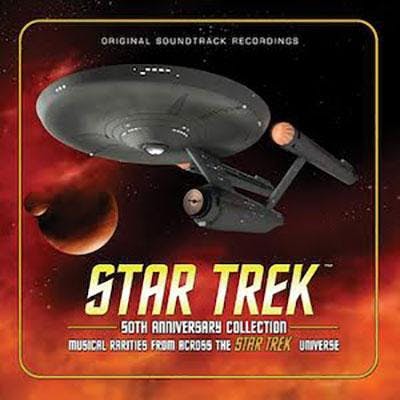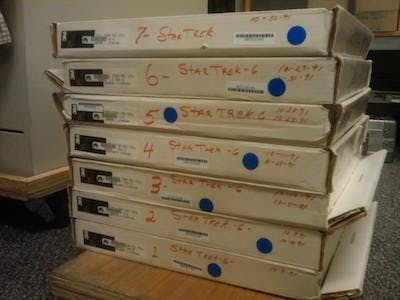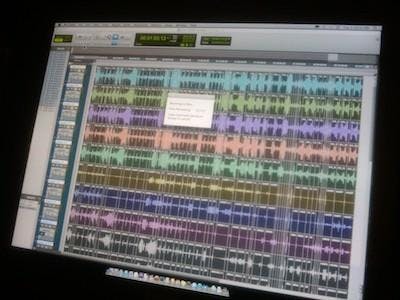Published Dec 2, 2016
Preserving Star Trek’s Musical Legacy
Preserving Star Trek’s Musical Legacy

La-La Land Records is celebrating the 50th anniversary of Star Trek with the release of “Star Trek: 50th Anniversary Collection — Musical Rarities from Across the Star Trek Universe,” a 4-CD album featuring music from the Star Trek TV series, movies, games and even theme park rides. The album includes the premiere release of the soundtrack to Star Trek: The Animated Series, long requested by fans.

While this set may be viewed as the culmination of Star Trek soundtrack releases, less than 10 years ago it may not have seemed possible. Star Trek debuted in 1966 and spawned a galaxy of collectible products: books, toys, models, clothing, comic books and much more. But what about soundtrack albums? The Original Series had some of the finest music ever composed for television, but while there were a few re-recordings of the theme over the years, it was not until the mid-1980s that a handful of soundtrack albums were released — most of them newly performed (not the actual recordings heard in the show) and featuring only highlights from selected episodes.
Star Trek: The Motion Picture(1979) marked the first time Star Trek fans and music lovers could finally own music heard in an actual Star Trek production. That album was arranged (as were most soundtrack releases of the time) specifically for vinyl, meaning each 20-minute side was designed for an optimum listening experience instead of following the chronological film order. The format of selected highlights (usually out of film sequence) continued for the feature films starring The Original Series and The Next Generation casts, even in the CD era.
In the late 1980s and ’90s, GNP Crescendo Records was the home for Star Trek soundtracks and they did a great job making television albums available from TOS, TNG, DS9 and Voyager — but business realities at the time (particularly involving the musicians union) precluded anything but occasional releases.
Starting in 2009 things began to change. Specialty soundtrack labels like Film Score Monthly, La-La Land Records, Intrada and Varèse Sarabande — as well as GNP Crescendo — began to release “collector’s editions” of the complete scores to the feature films (excepting Star Trek Beyond, which is too recent), along with multi-disc collections from the television series. No longer hindered by the time constraints of an LP or expensive “re-use” fees to the Hollywood session musicians (owing to an important policy change by the musicians union), these limited-edition releases offer the full scores, painstakingly assembled to reflect the music as heard in the productions. Film Score Monthly released a 14-CD box set featuring composer Ron Jones’s music from TNG, while La-La Land Records released the mammoth 15CD set of music from TOS — satisfying many fans who waited nearly 50 years to have all of this music. La-La Land Records has also released multi-disc collections from TNG, DS9 and Enterprise, with a Voyager set scheduled for early 2017.
So how does all of this music get released? First, deals are made between the studios (CBS for the television soundtracks, Paramount Pictures for the features) and, if applicable, the original record label that released the LP or CD. (Usually the original record companies have the soundtrack rights in “perpetuity deals,” meaning they have to be involved.) This can require the studios and labels to dig through paperwork to make sure the original contracts are in order and that all the royalty obligations are understood.
After deals are approved, the studios’ physical elements are requested. These tapes can vary in shape, quantity and configuration. Producing the albums is like re-experiencing technological change, with different analogue and digital tape formats appearing and disappearing over the years. For example, TMP was recorded onto 37 reels of 2'' 16-track analog tape, but by 1991, Star Trek VI: The Undiscovered Country was recorded onto seven 1'' 32-track digital tapes. (Today, music is recorded directly to hard drives with computer software.) The goal is to always go to the earliest, best source.

Once the tapes are transferred it’s up to producers, editors, mixers and mastering engineers to shape the final albums. This is like re-assembling a jigsaw puzzle: all of the correct musical takes, choral overlays (if applicable), “sweeteners” and revisions from the scoring process have to be located and reconstituted. The expanded Star Trek CDs have had a remarkable continuity, with many of the same people working on all of the releases (despite the different boutique labels). The goal has always been to present the complete music as heard in the film in film sequence. Ideally the albums present the master mixes made for the film (mixing being the process in which the disparate instrumental channels are combined into the final stereo master) but sometimes the best results come from doing new mixes. For La-La Land’s 3-CD set of TMP, Bruce Botnick, Jerry Goldsmith’s longtime scoring mixer, personally undertook a new album mix.

Television soundtracks can be simpler to assemble compared with the feature films, but they have their own challenges. TV scores by their nature are shorter than feature film scores (with shorter musical selections or “cues”) and the recordings are usually done in a day. However, when producing collections of TV music, vast amounts of tapes need to be transferred owing to the number of episodes. For the 15-CD TOS set, over 100 tapes were utilized. Many of these were the first-generation tapes—the ones that literally came off the ¼'' tape deck at the scoring stage—although in some instances, either due to damage or unavailability, second-generation dubs were used.

Thankfully for most of these Star Trek projects, finding the right tapes hasn’t been a problem. Modern-day film studios are well aware of the value of their entertainment properties (especially Star Trek) and meticulously archive their production materials. However, after much searching, original scoring master tapes could not be located for The Animated Series. (The production company, Filmation, disbanded years ago and its assets have changed hands several times.) For the new "Star Trek: 50th Anniversary Collection," the final TAS edited and mixed episode “stems” were used. These tapes are the final mono dubs synchronized to the shows, broken down into three individual channels: dialogue, effects and music. The music channels have edits and volume fluctuations because, by their nature, they’re meant to be played in synch with the episode. With careful listening, editing, and restoration, over 30 minutes of TAS music was recovered and is now available for the first time anywhere.
It wasn’t that long ago that most of this music was sealed away in a vault. Thanks to these labels and Star Trek fans supporting them, fans will be able to listen and enjoy this great music for generations to come.
Listen long and prosper.
Neil S. Bulk is a freelance soundtrack producer. He is an associate producer on Star Trek: 50th Anniversary Collection and worked on the reconstruction of music from Star Trek: The Animated Series. He can be reached at @nsbulk.

